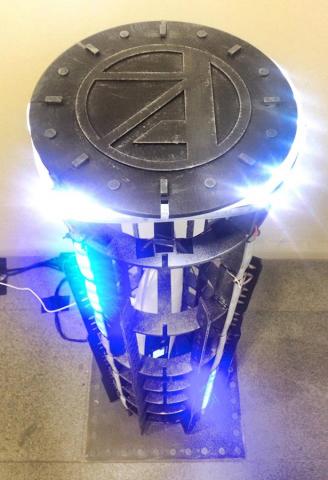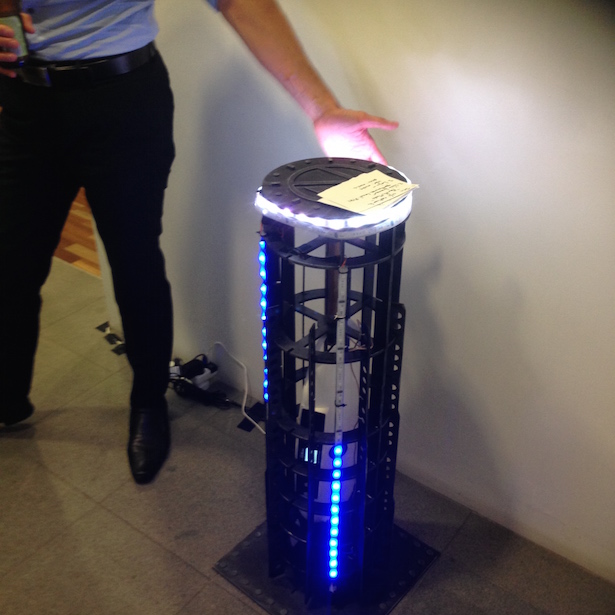
For Australia’s first “Hack the Festival”, team Artifactory combined to develop the Sonic BollART. This blog documents the story behind building the artwork.
Background
Hack the Festival invited participants to build a digital artwork and “hack” a piece to contribute to the Perth International Arts Festival. This Hack was a bit different to a tradtional one-day or weekend Hack, whereby participants could present the rough concept on a Wednesday, have the full day Hack to start the project the following Saturday. Then finally, present a finished prototype on the following Friday to the judges. Thus there is a week (outside of our working lives) to finish the digital art product. The winning entry receives a $5000 prize to help build their project.
Our initial grouping (Team Artifactory) started with four members: Skot McDonald, Tim Gilchrist, Meg Travers and me (Morgan Strong). Our initial idea was a hacked Roomba vacuum cleaner with a tablet attached that would chase people and pick arguments. This was quickly abandoned for the eminently more sensible idea of placing a theremin inside a bollard. As trivial as this sounds, it quickly evolved into something much more...
When the time came to present the concept to our peers at the official launch of Hack the Festival (the Wednesday event), Craig Wale joined Team Artifactory and the infant concept of the Sonic BollART was first presented.
Starting with the bollard...
All jokes aside, the bollard does represent a significant opportunity for public art, and a serious barrier to access. We started by thinking how can we make a bollard more accessible?
Bollards do not only restrict access, they create barriers. People with vision impairment cannot find bollards easily. Sound addresses this issue. If a bollard can make sound in relation to proximity it makes it more accessible to everyone. And if we can turn them into a musical instrument, then we make this mundane object both playful and accessible.
So naturally, our idea of adding a theremin to a bollard made perfect sense to fulfill these roles.
What is a theremin?
A theremin is one of the first electronic instruments. It consists of a metal antenna with a capacitor that changes pitch and volume as people move closer to the antenna. The theremin produces a distinctive wobble sound that modulates with hand and body gestures. The fact that a theremin makes such a distinctive sound and is responsive to movement made it a perfect addition to our musical bollard.
But there are problems with using a bollard in this way. The surface area of steel bollards are not conducive to be used as a theremin. They contain too much metal and the static interferes with the capacitor of the theremin.
Thus to make this a successful work we needed to re-invent the bollard; while being mindful of the functional purpose as an actual bollard.
But before then, we had to think about how to make the theremin more playful.
A visual reward; the Easter Egg.
To make the musical bollard engaging, we quickly realised there needed to be nice visual element. An Easter Egg concept. So we decided that a LED strip could be used that we could program to respond to the sound produced by the theremin (OK I admit it's not a particularly well-hidden Easter Egg, but this can always be developed more in the future).
So at the outset we’ve got a bit of an idea and a concept. We’re going to rethink bollards, make them musical and give a responsive light show. (Spoiler alert - the idea evolves a lot from here). But it’s now time to start the Hack and build us a musical bollard.
Day 1 - The Hack - the build begins
We started with a Moog theremini. This is basis of the theremin. To fit this large instrument in the artwork, it must be turned sideways.
A Moog Theremini
In this vein, we decided to put everything within the bollard. This means the bollard must be fairly large to accommodate all the equipment.
Ingredients
There are many components:
- 30cm diameter buckets.
- Tape to connect the buckets.
- Reinforcement.
- Moog Theremini.
- Chicken wire antenna.
- Sand base to weight the bollard.
- Speaker amplifier for the theremin.
The bucket frame concept was quickly abandoned in favour of a more robust material that would allow you to see the internal workings.
We decided to use MDF to build the supports and exoskeleton, the base was planned be 260mm, with a height of 900mm. Large enough to accommodate the Moog Theremini. We also planned to put a chicken wire antenna running through the middle of the MDF case. The MDF will be painted a metallic colour to resemble a steel bollard. The bottom of the bollard will be weighted down with sand.
If the prototype were to made into production, a different material would need to be used. Probably a concrete cast. We’ll get back to that later.
Creating a prototype
Time to start building. For the first step we decided to was get electrical supplies.
Building the bollard
Half the team decided to go offsite to use the power of a laser cutter to build the MDF bollard frame.

The required skeleton shapes are set into a large sheet of MDF.

Now it is time to cut out the shapes.

And assemble the bollard frame...
...Into a functional bollard.
The team also designed a place for a copper antenna to be placed within the top of the frame to replace the chicken wire antenna. This will give us more control, and be more visually appealing.
Building the visual Easter Egg
The other half of team decided to work on connecting the theremini with the LED lights. This process started by connecting an addressable LED strip to a computer and developing a process for the LED strip to respond to a voltage input. The strip lights up and alternates in colour according to this input.
The next step was to connect the theremini to the LED strip. The pitch of the theremini is mapped to a voltage reading between 1-5 volts and this information was converted into a signal for the LED strip. This strip is then connected to an arduino board that is used to process the voltage and thus output a control the colours of the LED strip.
We have the concept of the Easter Egg and responsive lights.
At the end of Day 1
So at the end of day one we had:
- A MDF frame of a bollard.
- A Moog Theremini ready to be placed within the bollard frame.
- An LED strip programmed to respond to the audio output from the theremin.
But we still needed to construct the piece, and also get the famously temperamental theremin to work responsively in its new bollard home. We also needed a plan on how to get the prototype into a functional musical bollard should we win the art hack prize.
Technically and functionally accessible
Both the program that powers the responsive lights and the design of the bollard itself will be available on GitHub for free download (some of the code is already available). By releasing the designs as open source we make the bollards accessible to the others to perpetuate the ethos.
How this is digital art
The musical bollard is playful and accessible; it is an unexpected interaction with an authoritative object playful.
A bollard is an inanimate object that is designed for you not to interact with it, we are re-imagining it so that it invites playful interaction. The bollard allows a truly democratising experience for all visitors, and the visitors can experience and play as they choose.
We drew on a feminist tradition to challenge the bollard’s masculinity and create an inclusive and inviting experiences with this authoritative object. And we drew on a dadaist tradition to rethink the way people interact with the object and throw those expectations on its head.
But perhaps most importantly, we’re making a public piece of art: we’re taking the bollard and making in inclusive and interesting.
The musical bollard as Sonic BollART
After some thought we realised this concept could easily scale. Bollards are everywhere, and each one of them represents an opportunity to make a piece of public art: BollART. They do not need to be musical, but as long as they are a functional bollard why not use them for additional purposes?
Just like “cow parade” events involving hundreds of custom painted cows placed in cities across the world, the concept of BollART has similar potential. However, the BollART concept has one fundamental difference: every bollard is required in the urban environment, and by converting them into BollART, they are creatively coaxed far beyond its basic raison d'être to delight and engage passersby. Whilst also public art, each BollART is part of the real, functional and unsung working fabric of the City. An exciting idea indeed.
Ethical considerations
1080 bait was briefly considered as a way to stop people destroying the artwork, but the internal ethics committee deemed this inappropriate. Otherwise, the project is geared towards making things accessible and fun and thus easily passed the team’s internal fairness test.
The working week
At the end of the hack, we had to fit the remaining build process around our working week. This meant very long nights for some of the team members. The author of this blog, being the least skilled in the required areas, got off pretty lightly in this respect.
Planning a production version
The Sonic BollART is built from MDF: not quite strong enough to restrict traffic. Thus we got to work on designing a design for a fibreglass reinforced concrete bollard. All the electric components would still be located within the bollard, with screw top for easy access. This concept would be possible by 3D printing out the cast moulds, and then laying concrete on top of the moulds that is reinforced by fibreglass. This would reduce the weight, as well as the need for concrete (an environmentally taxing product) and keep the product robust enough to function as a bollard. This product could be reproduced from the mould to start the BollART movement, and each unit would cost around $350 to produce.
Developing a production BollART design.
Adding dead drop music capacity
Because a theremin with a responsive light show was not quite enough, we decided to add a dead drop Wi-Fi music hub.
We acquired a small Wi-Fi router and hard disc so that we could set up a wireless, offline file-sharing service. This would mean that this music bollard would not only be an instrument, but also a place for local musicians to place their recordings, and for any member of the public to access it. Local music available offline, and for free.
And building the product!
Finally, we had to build the bollard.
Setting up at Perth Artifactory to construct the Sonic BollART.

Setting the bollard frame.
Because two soldering irons is ALWAYS better than one.
The presentation night
Well when it came to presentation night… Things went… Pretty well actually.

The functioning, installed Sonic BollART.

The Perth Artifactory bollard top.
First of all we had to set it up.

Once it was in place, came the fun part of tweaking the capacitor of the theremin relative to the space where the bollard was located. This took a while. But once it was right, it was working, and it was ready to present to the judges.
And… we won!!

Team Artifactory (left to right: Skot McDonald; Morgan Strong; Tim Gilchrist; Meg Travers; Craig Wale), with Department of Culture and Arts Director-General Duncan Ord at the award presentation.
Huge congrats to the team who worked so hard to get this running. Next stop, BollART in production.

Comments
I love this artwork